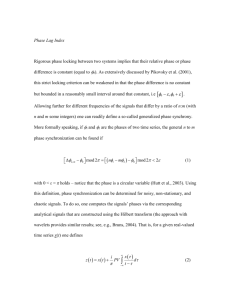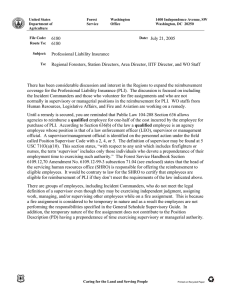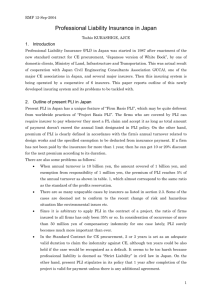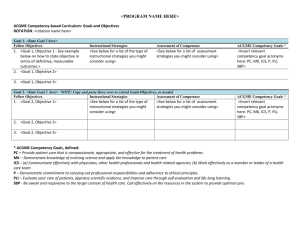Understanding Aspects Mitchell Wand Northeastern University August, 2003
advertisement
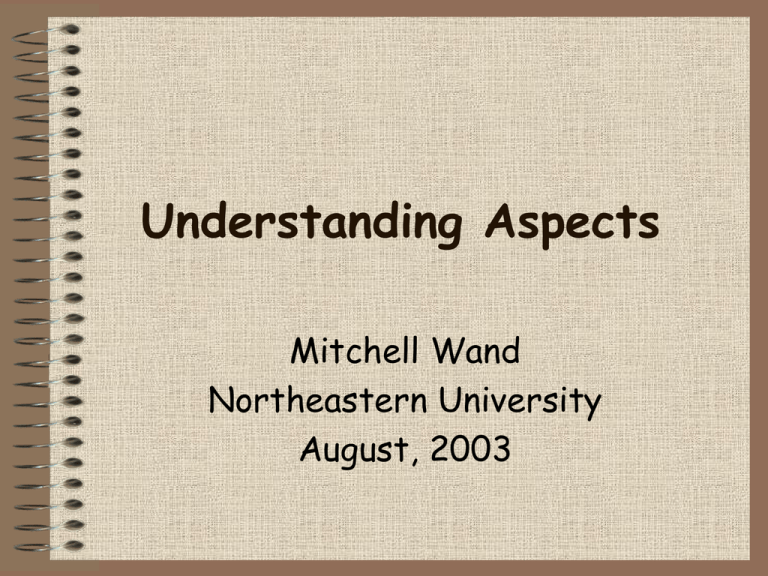
Understanding Aspects
Mitchell Wand
Northeastern University
August, 2003
Goals for the talk
• Report on my efforts to figure out
what AOP is about
• Suggest some ways in which PL
research can be applied to AOP
PLI 2003
2
Outline
1. Background: what problems was
AOP intended to address?
2. Examples
3. Shortcomings of current efforts
4. Reconceptualizing AOP
5. Implications for future research
PLI 2003
3
The problem
• Limitations of traditional layered
architectures
• Different research groups tell
different motivating stories:
– Tyranny of the primary decomposition
– Crosscutting concerns lead to scattered
and tangled code
PLI 2003
4
Tyranny of the primary
decomposition
• Want to assemble programs from
different subsystems
• Each subsystem has its own idea of
how program should be organized and
who’s in control
• Multiple views of program lead to
combinatorial explosion of methods
• Want effect of multiple inheritance
PLI 2003
5
Example systems
•
•
•
•
HyperJ [Ossher-Tarr et al]
Jiazzi [Flatt et al]
Mixin Layers, GenVoca [Batory et al]
Composition Filters [Aksit et al]
PLI 2003
6
Crosscutting concerns lead
to complexity
• Applications typically need multiple
services:
– logging, locking, display, transport,
authentication, security, etc
• These services don't naturally fit in
usual module boundaries
("crosscutting")
PLI 2003
7
Scattering and tangling
• These services must be called from
many places (“scattering”)
• An individual operation may need to
refer to many services (“tangling”)
PLI 2003
8
Example of scattering
[Kiczales 2001]
• logging in org.apache.tomcat
– each bar shows one module
– red shows lines of code that handle logging
– not in just one place, not even in a small number of places
PLI 2003
© Copyright 1999, 2000, 2001 Xerox
Corporation. All rights reserved
.
9
So what’s the problem?
• Functional programmers know
the answer: use proxies or
wrappers
(define doit
(let ((old-doit doit))
(logged-version old-doit)))
PLI 2003
10
Why isn’t that enough?
• How to make sure an application calls
the right proxy?
• Potential for conflict with calls to
multiple services
– combinatorial explosion of wrappers
– tangling
PLI 2003
11
The real problem
• Each application has a policy about
when each service is required
• But the policy is built into the
structure of the program
• Hard to understand, modify, etc, etc
PLI 2003
12
A solution
• Add a policy language that describes
where each service needs to be
called
– policy language is declarative
– localizes knowledge about policy
PLI 2003
13
Examples
• D [Lopes-Kiczales 97]
– had policy languages for several kinds
of services
• locking/mutual exclusion (COOL)
• transport (RIDL)
• proposals for others
– Each such service became an “aspect”
• QuO [BBN 00]
– policy language for network transport
PLI 2003
14
COOL example
[Lopes 97]
coordinator BoundedBuffer {
selfex put, take;
mutex {put, take};
condition empty = true, full = false;
put: requires !full;
on_exit {
if (empty) empty = false;
if (usedSlots == capacity) full = true;
}
take: requires !empty; ...
PLI 2003
15
QuO Example
contract UAVdistrib {
sysconds ValueType actualFrameRate, ... ;
callbacks sourceControl, timeInRegion ;
region HighLoad (actualFrameRate >= 8) {
state Test until (timeInRegion >= 3) {}
...
transition any->Test{
sourceControl.setFrameRate(30);
timeInRegion.longValue(0);
}
...
} ... }
PLI 2003
16
Limitations of this
approach
• What are aspects, anyway?
• Is there some fixed finite set of aspects?
– Might even want to express some functional
behavior as aspects
• Need to analyze each aspect, then develop
and maintain a language for it
• Proliferation of languages for individual
aspects
• Bad for technology transfer
PLI 2003
17
AspectJ
[Kiczales et al 01]
• Kiczales’ strategy: develop a single
language in which all aspects could be
expressed
• Use Java as base language
• Allow the community to concentrate
its efforts on a single tool
PLI 2003
18
Ideas of AspectJ
• Policy specified in terms of join points at
which actions could be attached
• Join points: events in the program
execution:
–
–
–
–
method calls
method executions
constructor calls
etc
PLI 2003
19
AspectJ, cont’d
• Policies expressed as sets of join
points, called point cuts
• Language of point cut descriptors
allows declarative specification of
point cuts
• Action at a point cut expressed as
advice before/after/around each
join point in the point cut
PLI 2003
20
Example
aspect LogPublicErrors {
[AspectJ manual]
each aspect packages a policy
pointcut publicInterface():
instanceof(mypackage.*) &&
pointcut declaration
executions(public * *(..));
static after() throwing(Error e): publicInterface()
{logIt(e); throw e;}
advice on this pointcut
static void logIt (Error e) { ... }
PLI 2003
21
What’s the difficulty?
• AspectJ point cuts are a powerful
reflection mechanism
• Can use them to detect and modify
otherwise unobservable program
behavior
• Ordinary local reasoning about
programs becomes invalid
PLI 2003
22
Meddling aspects
Does m2 always print
class C
55?
{static int foo;
static final void m1() {foo = 55;}
static final void m2()
{m1(); println(foo);}
}
aspect Meddle {
void after() :
Ouch! My aching
void call(C.m1())
invariant!
{target.foo = 66}
}
PLI 2003
23
Aspects can detect
refactoring
class C {void foo (){..} ..}
class D extends C {}
class C {void foo (){..} ..}
class D extends C {
void foo (){super.foo();}
}
returns w/o
aspect Distinguish {
calling super
void around():
execution (void D.foo())
{println(“gotcha!”);}}
PLI 2003
24
Aspects can distinguish
non-terminating programs
class C {static final void foo(){foo();}
static final void bar(){bar();}} #1
class C {static final void foo(){bar();}
#2
static final void bar(){bar();}}
aspect Distinguish {
void around():
executions(void C.bar())
{println(“gotcha!”);}}
makes c.foo() halt in #2, not in #1
PLI 2003
25
Why is this so bad?
• Can no longer do local reasoning
about programs; can only do wholeprogram reasoning
• Defeats encapsulation, which is basic
SWE principle
• Tools such as aspect browsers can
help, but scalability is a question
mark
PLI 2003
26
Where did we go astray?
• Previous AO Languages were
conjunctive specifications
• Can think of each aspect as a partial
specification of behavior of the
machine
• conjunctive = orthogonal
PLI 2003
27
What AspectJ changed
• But AspectJ is an exceptive specification!
• “Base program” is intended to be a
complete specification of a JVM behavior
• Advice changes the behavior
• Now reasoning is much more difficult
• Level much too low-- no room for partial
specification
PLI 2003
28
Reconceptualizing AOP
• Scattering is inevitable
• Aspects are modular units of
specification
• A join point model is a shared
ontology
PLI 2003
29
The conspiracy theory of
programming
• A specification represents a
conspiracy between two or more
pieces of program.
• (pop (push x s)) = s specifies a
conspiracy between push and pop.
• push and pop must agree on the
representation of stacks.
PLI 2003
30
Good conspiracies are local
• If we change the representation of
stacks, we need only change push and
pop to match; client need not change
• This is good if push and pop are in
the same module
PLI 2003
31
Distributed conspiracies
are harder
• A policy is a cross-module
specification
• Changes to representation or to
specification require changes in many
modules
PLI 2003
32
Example
• Policy: "logging should occur
whenever events in set X happen"
• If you change X, you may have to
change all the modules in which X
may happen
• This is root cause of scattering
• Conclusion: scattering is inevitable!
PLI 2003
33
How to escape
• Don’t think about programming, think
about specification
• An aspect is a modular unit of
specification
PLI 2003
34
Examples
• Standard examples:
– Base functionality, logging, security,
persistence, etc
• Each of these is best specified in its own
language
• Policy language must intersect all of these
languages
– intersections are join points
• So it must know something about each of
them. Therefore:
PLI 2003
35
A join point model is a
shared ontology
• A join point model is a shared
ontology, representing the aspects’
shared understanding of their joint
specificand
• The join points are a class of entities
in that shared ontology
PLI 2003
36
What is an ontology?
• Specifies a domain of discourse
• Specifies the structure of entities in that
domain
• May specify additional constraints
• Can have different ontologies for the
same entities
– different data represented
– different constraints
• Languages for writing ontologies
– UML/OCL, RDF, DAML/OIL
PLI 2003
37
Ontologies as Agreements
• Agents agree on names for things
and their behaviors
• Each agent may bring additional
knowledge about the domain, not in
the shared portion of the ontology
PLI 2003
38
Example: lexer/parser
communication
• Agents:
– Lexers and parsers
• Domain of discourse:
– lexical items
• Ontology:
– each item has a lexical class, data, and
debugging info
• Join points:
– names of lexical classes
– Lexer and parser must agree on these names
PLI 2003
39
Example: ADT’s
• Agents:
– server (ADT implementation) and its clients
• Domain of discourse: procedure calls
• Ontology:
– includes agreement on the semantics of a
procedure call
• Join points:
– names of procedures in interface
– Client and server agree on the names of
procedures to be called, and on their behavior
PLI 2003
40
Procedures vs. methods
• In Java, can do the same thing, but
domain of discourse is method calls
instead of procedure calls
• A procedure-oriented client can’t use
an object-oriented server!
PLI 2003
41
Widening our horizons
• With this new perspective, we can
look for hidden aspect-orientation in
other languages
• So: what is the world’s most popular
aspect-oriented language?
PLI 2003
42
Microsoft Word!
43
Microsoft Word
• Different aspects:
– Contents aspect
– Formatting aspect, with subaspects:
• Font
• Indentation/Margin
• Borders/Shading, etc
• Structure of menus mimics the
structure of this ontology
PLI 2003
44
Word example, cont’d
• Not a programming language
• But has some weak abstraction
capabilities: styles
• Also has a weak policy language, e.g.:
“whenever you reach the end of a
paragraph in Style1, start the next
paragraph in Style2.”
PLI 2003
45
Aspect-oriented
programming reconsidered
• Let’s see how some AOP languages
fit into this framework
PLI 2003
46
AspectJ
• Domain of discourse:
– execution sequences of an idealized JVM
• Ontology:
– an execution consists of a sequence of object
constructions, method calls, method
executions, etc. Each such event takes place in
a dynamic context (the cflow)
• Actions:
– execute advice before/after/around each
event in the ontology
PLI 2003
47
Composition Filters
[Aksit et al 92]
• Domain of discourse:
– OOPL execution sequences
– like AspectJ
same domain of
discourse, different
ontology
• Ontology:
– method calls
• Action:
– interpose filters
PLI 2003
48
Composition Filters, cont'd
• filter runs an incoming message through a
decision tree,
– based on pattern-matching and boolean
"condition variables" set from code
– so filter can have state
• filter can then dispatch the message to
different methods, reify, queue messages,
etc
• Does this raise the same difficulties as
advice? Good question!
PLI 2003
49
Hyper/J
• Domain of discourse:
– Java program texts
• Ontology:
[Ossher-Tarr 99]
texts, not
events
– a Java program is a set of packages, each of
which consists of a set of classes, each of
which consists of a set of methods
• Actions:
– collect methods into classes
– associate a method body with each method
name
PLI 2003
50
DemeterJ
[Lieberherr 96 et seq]
• Domain of discourse:
– Graph traversals
• Ontology:
– a graph traversal is a sequence of node
or edge visits
• Action:
– call a visitor method at each event
PLI 2003
51
PL research in AOP
• Descriptive:
– [de Meuter 97], [Andrews 01], [DouenceMotelet-Sudholt 01], [Lammel 02], [WandKiczales-Dutchyn 02]
• Compiler Correctness
– [Masuhara-Kiczales-Dutchyn 02],
[Jagadeesan-Jeffrey-Riely 03]
• Core Calculi
– [Walker-Zdancewic-Ligatti 03]
PLI 2003
52
Research Directions
• Some ways in which the PL
community can make AOP safer
PLI 2003
53
Higher-level join-point
models
• AspectJ ontology is that of OO assembly
language
– universal, but too low-level
• Better idea: make the join-point model
part of the system design
– UML represents a system-wide shared
ontology of data
– can we do the same thing for join points?
– example: Emacs-Lisp hook system
– example: [Heeren-Hage-Swiertsa 03]
PLI 2003
54
Domain-specific aspect
languages
• Each aspect is best specified in its own
vocabulary
• First-generation AO languages had it right
– But development, deployment costs too high
• We can do better:
– build tools and environments to support
DSAL’s
• This is the real long-term win for AO
ideas
PLI 2003
55
Example: Scripting Type
Inference
• Join point model
[Heeren-Hage-Swiertsa 03]
– inference steps in the typechecker
– inferences contain unifications (= jp's)
• Language for describing them
• Language for advising them
– action: on failure print <whatever>
• Soundness is guaranteed
– can't cheat
PLI 2003
56
Aspect-oriented reasoning
• Goal: restore possibility of local reasoning
• We reason locally about program
fragments by making assumptions about
the class of contexts in which they will be
executed
– type assumptions: consider only well-typed
contexts
– evaluation assumptions: we don't consider
contexts like println("[]")
PLI 2003
57
Specifying contexts
• Can we formalize our assumptions
about contexts with aspects? e.g.:
– which join points are visible to the
context
– what portion of the state the advice is
allowed to change
• With such contextual assumptions,
we could restore the possibility of
local reasoning
PLI 2003
58
Conclusions
• AOP is getting a lot of attention in the
SWE world
• Current popular AOP mechanisms (eg
global advice) seem flawed
– too low-level, can't do local program reasoning
• We ought to be able to do better
– more semantics in the join point model
– more semantics in the aspect languages
– more semantics in the contextual assumptions
PLI 2003
59
The End
Slides available soon at
http://www.ccs.neu.edu/home/wand
PLI 2003
60
